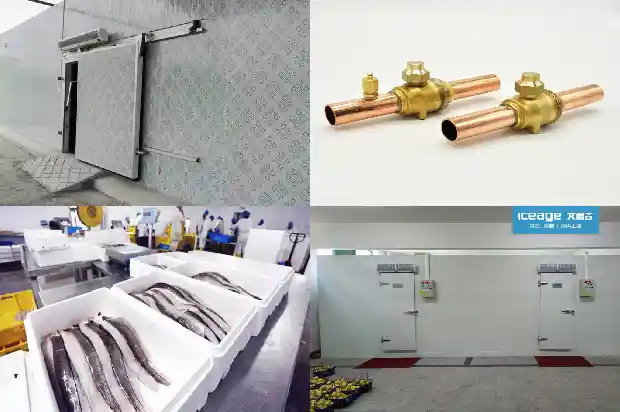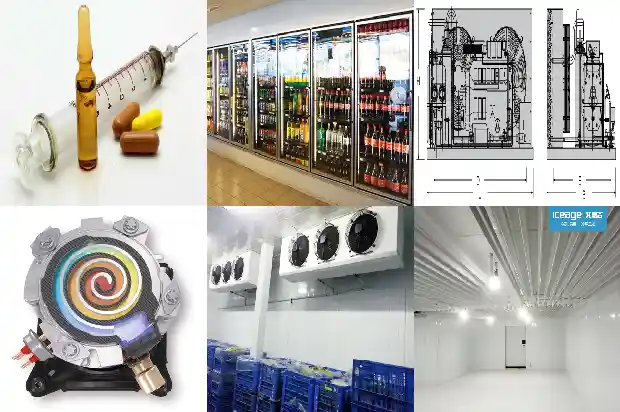Reasons for Pump Body Failures in Cold Storage Compressors
2024-12-03
During the operation of cold storage, certain problems are bound to be encountered.

A scroll compressor has two scroll plates, namely the orbiting scroll and the fixed scroll. Together with the sealing materials, they form the compression chambers of the scroll compressor. Generally, scroll compressors used in air conditioners have a three-stage compression process, and the volume of the last-stage compression chamber is basically one-third of the inhaled gas. When a large amount of liquid enters the scroll plates, due to the incompressibility of the liquid state, under the effect of instantaneous high pressure, the scroll plates are bound to break.


When the compressor is started, a large amount of refrigerant liquid enters it. After the unit has been running and is left overnight, part of the refrigerant flows back to the bottom of the compressor, or if the refrigerant charge in the unit system originally exceeds the standard, liquid refrigerant will accumulate at the bottom of the compressor. At the moment when the compressor is started, the liquid refrigerant, along with the lubricating oil, rushes into the scroll plates, causing hydraulic impact and resulting in the breakage of the scroll plates. Generally, compressor manufacturers will recommend installing a preheating belt at the bottom of the compressor. Turn on the preheating belt 6 hours before starting the compressor to preheat the refrigerant at the bottom so that the bottom refrigerant can evaporate. However, in practice, this measure is not very practical.
During the defrosting process of the heat pump, the refrigerant does not fully evaporate before entering the compressor. When the air conditioner is operating in heating mode, the refrigerant flows into the compressor in a vapor state. At this time, the gas-liquid separator is in a low-pressure state, while the evaporation side is in a high-pressure state. After the machine receives the defrosting instruction, the four-way valve operates, and the evaporation side is connected to the gas-liquid separator. A large amount of liquid accumulates in the gas-liquid separator and then flows into the compressor, causing excessive liquid slugging. Therefore, in some air conditioning systems, a liquid level detection device is adopted. When the liquid level reaches a certain level, the system sends an instruction to stop defrosting. This protection device effectively prevents liquid slugging during defrosting.
Impurities and moisture enter the scroll plates of the compressor. The sources of impurities mainly include two major parts:
- Welding impurities in the air conditioning system pipelines, insufficient cleanliness of key components such as pipeline condensers and evaporators, and burrs generated during component processing.
- Burrs generated during the processing of compressor system components, metal particles produced by the wear of moving parts, and impurities generated by the abnormal operation of the compressor. Moisture mainly comes from the system being exposed for too long during installation. If these impurities and moisture enter the scroll plates of the compressor, the scroll plates are prone to damage. Some manufacturers have developed a radial flexible structure in response to this problem and achieved certain results.
Bushing burnout
This failure mainly occurs in the bearing between the orbiting scroll and the main shaft. Due to insufficient refrigerant in the system or the reverse rotation of the compressor, which causes an abnormally high temperature in the center of the scroll, the bottom of the orbiting scroll heats up rapidly, resulting in the burnout of the bushing of the bearing. In addition, the abnormal high temperature of the motor can also lead to the burnout of the motor bushing and the burned bushing.
This failure mainly occurs in the bearing between the orbiting scroll and the main shaft. Due to insufficient refrigerant in the system or the reverse rotation of the compressor, which causes an abnormally high temperature in the center of the scroll, the bottom of the orbiting scroll heats up rapidly, resulting in the burnout of the bushing of the bearing. In addition, the abnormal high temperature of the motor can also lead to the burnout of the motor bushing and the burned bushing.
Bushing wear
Poor lubrication is the main cause of bushing wear. When the refrigerant in the system exceeds the standard, the compressor experiences excessive liquid return, the compressor starts frequently, foreign objects enter and cause the oil film to break or clog, or there is an abnormally high temperature in the bearing part, all of which can lead to poor lubrication. When moisture enters the system, it causes rust spots on the parts, resulting in wear. In severe cases, it can cause the shaft to seize up and the machine to stop working, and the bushings will be worn.
Poor lubrication is the main cause of bushing wear. When the refrigerant in the system exceeds the standard, the compressor experiences excessive liquid return, the compressor starts frequently, foreign objects enter and cause the oil film to break or clog, or there is an abnormally high temperature in the bearing part, all of which can lead to poor lubrication. When moisture enters the system, it causes rust spots on the parts, resulting in wear. In severe cases, it can cause the shaft to seize up and the machine to stop working, and the bushings will be worn.
Related Articles
- What Are the Common Reasons for Difficulties in Cooling a Cold Storage?
- Analysis of Seven Reasons for Ice Formation in Computer Room Air Conditioners
- Reasons for Frost Formation in Cold Storage and Defrosting Methods
- What Are the Reasons for Insufficient Air Output of Screw Air Compressors?
- What are the reasons for the inactivity of the automotive air conditioning compressor? What are the common faults?
- What are the reasons for the frequent start-up and tripping of the refrigerated air dryer in the cold storage?
- Reasons and Solutions for High and Low Condensing Pressure in Air-cooled and Water-cooled Systems
- 15 Reasons for Excessive Temperature Rise of Motors
- Reasons for Installing Thermal Insulation Layers in Cold Storages
- What are the reasons for the poor oil return of screw compressors?
- 7 Reasons for Low Air Pressure in Cold Water Unit
- Reasons for Higher Cost of Controlled Atmosphere Cold Storage than Ordinary Cold Storage
- Five potential reasons for the deteriorating performance of car air conditioning
- Nine common reasons for compressor damage
- Maintenance Methods for Small Modular Cold Storage Failures
- Do You Know These Four Scenarios That Can Cause Compressor Failures?
- Refrigeration System Failures: Handling System Blockages and Water Infiltration
- Solutions to Common Compressor Failures
